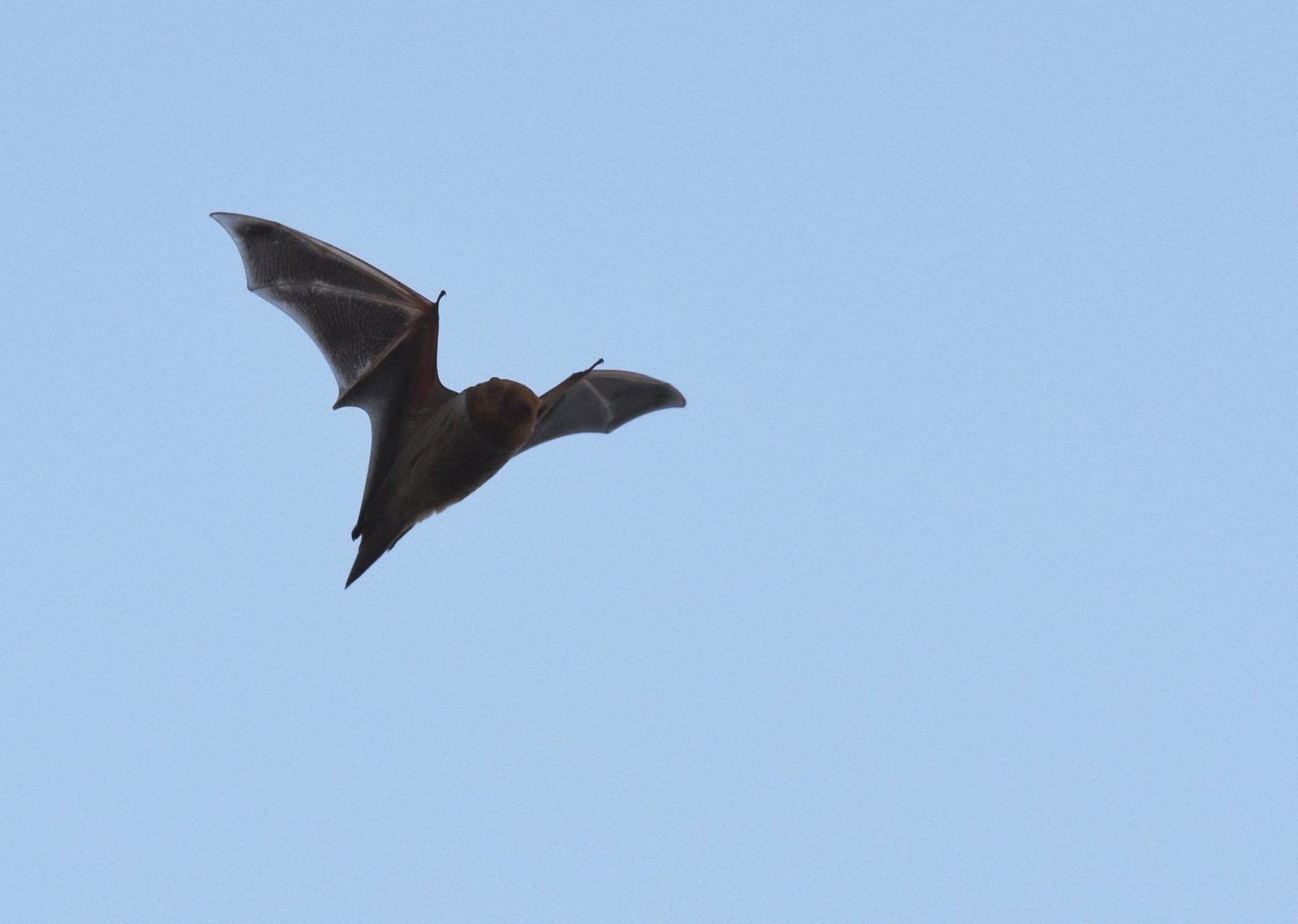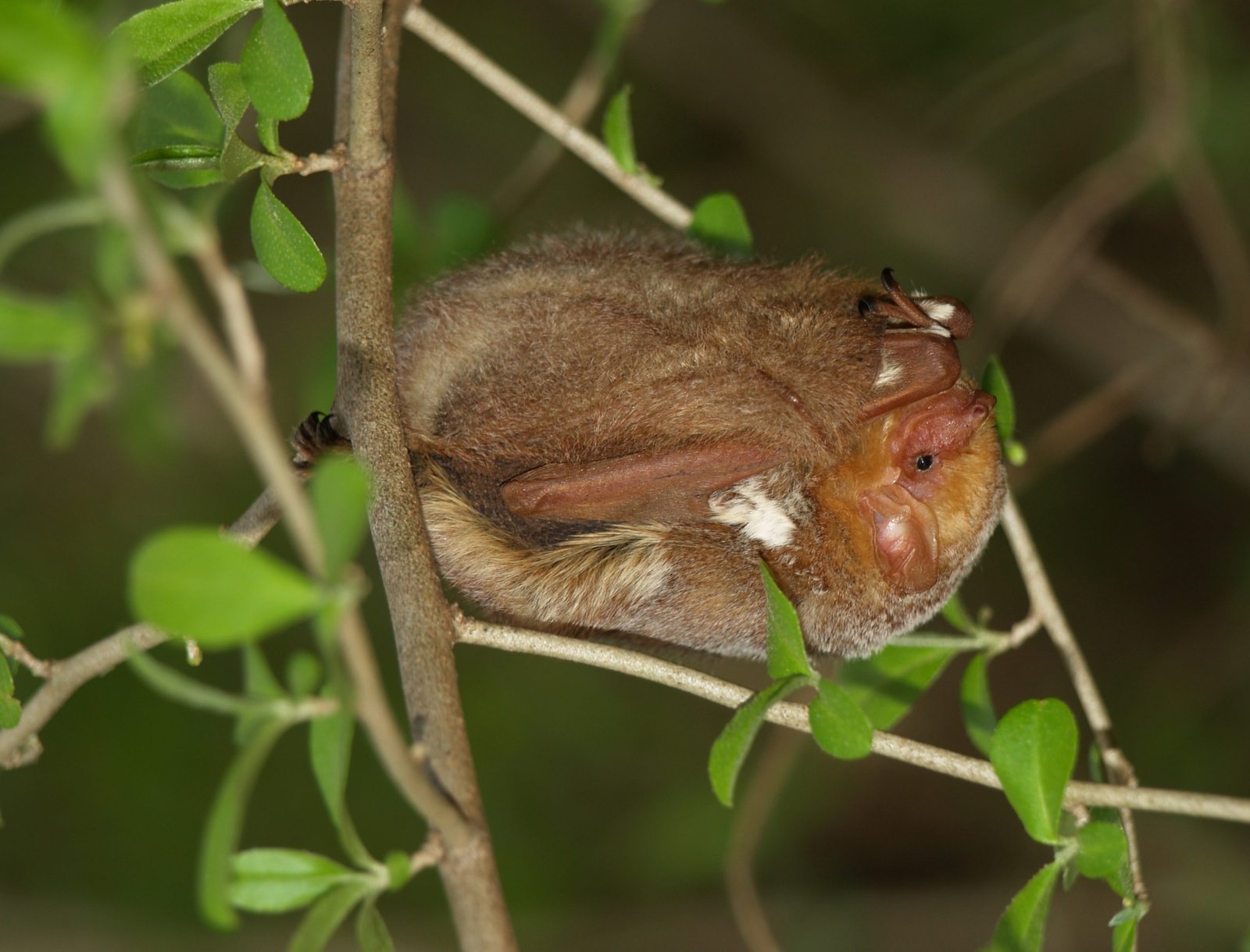Eastern Red Bat: Lasiurus Borealis

Eastern red bats are the most abundant “tree bats” in North America. From as south as central Florida and as north as Canada, they are found wherever there are trees east of the Rocky Mountains. Irn the foliage of deciduous or sometimes evergreen trees, Eastern red bats roost.
Despite their bright reddish color, these bats are somewhat cryptic, looking like dead leaves or pine cones. As they hang curled-up in their furry tail membranes, suspended from a single leg, twisting slightly in the breeze, they are perfectly camouflaged. 1Go To Source batcon.org -“Lasiurus Borealis”
Learn More: Species Of American Bats
Physical Characteristics Of The Eastern Red Bat
Red bats are medium-sized bats with a total length of 93 to 117 mm. The body length is about 40 to 50 mm, and the weight varies from 7 to 13 g. The hindfoot’s size is 6 to 11 mm, and the height of the ear is 8 to 13 mm from the notch. The forearm length ranges from 36 to 46 mm.
From a brick red to a yellowish red color, the bat’s pelage varies in color. The fur at the tips is white, giving a frosted appearance to these bats. Compared to males, female bats seem more frosted, and males have a redder color than females. In size, there is no documented sexual dimorphism.
The uropatagium (membrane between the thighs) on the dorsal side is densely furred and keeps these bats warm in cold weather.
There are small and heavily constructed skulls of Lasiurus borealis. The 32 teeth arrangement is distinctive and shared with other species of Lasiurus. Red bats have a short upper premolar shaped cone located on the upper canine and the second premolar inner junction. 2Go To Source animaldiversity.org -“Lasiurus borealis red bat”
Eastern Red Bat Behavior
The eastern red bat, except during mating and migration, is a solitary bat. It hangs 4 to 10 feet above the ground during the day, among the dense foliage.
In the winter, the eastern red bat migrates to the southern part of its range in flocks. Migration and reproduction are the only times this species will group together.
During the cold winter months, the eastern red bat hibernates. It may emerge from hibernation to feed on warm days. 3Go To Source nhpbs.org -“Eastern Red Bat – Lasiurus borealis”
Migration Patterns Of The Eastern Red Bat

Some red bats in the southern states may remain in the same areas throughout the year, but they are a migratory species in the northern U.S. and Canada, and most of the Plains States.
Travel to the South appears to be associated with the passage of cold fronts in the fall.
In separate groups, the sexes are thought to migrate and may actually travel with other bat species.
From August to October, many red bats have been recorded migrating during the day. Some of them have even been seen flying over the Atlantic Ocean. 4Go To Source tpwd.texas.gov -“Eastern Red Bat (Lasiurus borealis)”
Eastern Red Bat Reproduction
Eastern red bats generally mate in August and September. During the winter, females store sperm in their reproductive tracts and ovulate in early spring.
1-5 young adults are born in June after a gestation period of 90 days. The red bats are the only known bats that usually have 3 or 4 young bats per litter.
Babies weigh about 0.5 g each at birth, and they weigh almost half of their mother’s weight by 4 weeks of age. Eastern red bats can fly around the age of 6 weeks and are ready for weaning around the same time. 5Go To Source discoverlife.org -“Eastern Red Bats”
Life Expectancy of Eastern Red Bats
The eastern red bat has an average lifespan of approximately 12 years. The length of this bat species’ life will differ depending upon environmental, location, and food source factors. Bats of similar species have lived up to 25 years in captivity.
Eastern Red Bat Diet
Eastern red bats are insectivorous animals (easts mainly insects). Like many other insectivorous bats, they capture insects while flying.
Red bats often hunt around lights for insects. At dusk, hunting for food starts, and the bat hunts within 500m of a light source. There is only one peak feeding time throughout the night, but records of these bats searching for food all night long are available.
Red bats swoop, fixing on a target within 5 to 10 m, through a concentration of potential prey. On average, they attack insects every thirty seconds and are forty percent of the time successful.
The moth can hear this if a bat stalks a moth using echolocation and will attempt to flee the attack by diving. The bat will go into a steep dive following the moth and often pull away within inches of the ground. Humans who observe this interaction between predator and prey only see the bat and not the moth and may think that the bat is aggressively acting towards them. 6Go To Source biokids.umich.edu -“Red Bat”
5 Common Prey Of The Eastern Red Bat
- Moths
- Grass Hoppers
- Flies
- Ants
- Beetles
Eastern Red Bat Habitat
Eastern red bats most often roost in tree foliage, shrubs, leaf litter, dense grass, or under house shingles. Roosting locations are typically 1-12 m above the ground and shaded from above but open (allowing for a quick escape).
Large trees provide crucial roosting habitats in urban or rural areas where woods have been cleared. They use a range of deciduous tree species for roosting; common ones include American elm, box elder, sweetgum, and oaks in the Midwest. Day roosts are often located along streams, open fields, near canopy gaps, or near urban areas, and edge habitats. 7Go To Source guides.nynhp.org -“Eastern Red Bat”
Sources:
- “Lasiurus Borealis.” Bat Conservation International, 1 July 2020, www.batcon.org/bat/lasiurus-borealis.
- Myers, P. and J. Hatchett 2000. “Lasiurus borealis” (On-line), Animal Diversity Web. Accessed December 09, 2020 at https://animaldiversity.org/accounts/Lasiurus_borealis/
- “Red Bat – Lasiurus Borealis – NatureWorks.” Nature Works, PBS, nhpbs.org/natureworks/redbat.htm. Accessed 9 Dec. 2020.
- “Eastern Red Bat (Lasiurus Borealis).” Texas Parks & Wildlife, TPW, tpwd.texas.gov/huntwild/wild/species/eastred. Accessed 9 Dec. 2020.
- Linzey, Don, and Christy Brecht. “Eastern Red Bat.” Discover Wildlife, Wytheville Community College, www.discoverlife.org/nh/tx/Vertebrata/Mammalia/Vespertilionidae/Lasiurus/borealis. Accessed 9 Dec. 2020.
- Myers, P. and J. Hatchett 2000. “Lasiurus borealis” (On-line), Animal Diversity Web. Accessed December 09, 2020 at http://www.biokids.umich.edu/accounts/Lasiurus_borealis/
- New York Natural Heritage Program. 2020. Online Conservation Guide for Lasiurus borealis. Available from: https://guides.nynhp.org/eastern-red-bat/. Accessed December 9, 2020.
